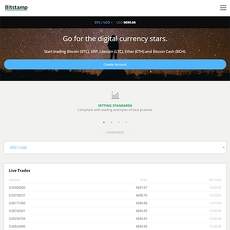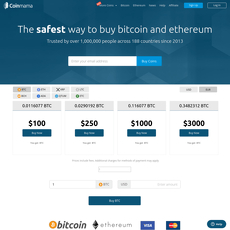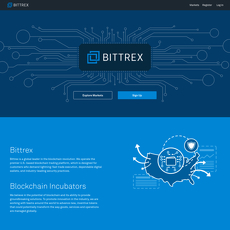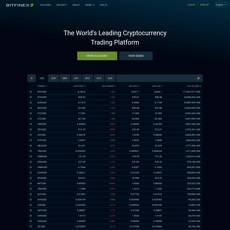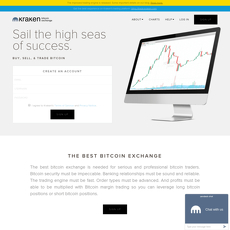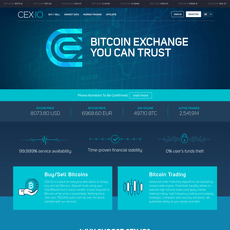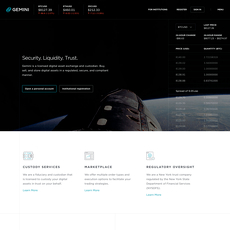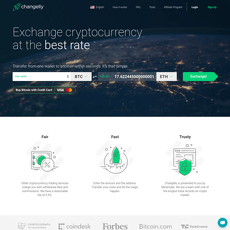Poloniex Review
Poloniex
poloniex.com
Poloniex: Everything You Need to Know – Honest Review, Guide, and FAQ
Ever wondered if Poloniex is actually worth using, or if you're better off checking out another crypto exchange?
With so many headlines about exchange hacks, sudden regulation crackdowns, and mystery fees, it’s no surprise that choosing the right crypto trading platform feels like walking through a minefield. Mess up, and you could be stuck waiting days for a withdrawal, get slapped with surprise fees, or—worst of all—see your funds disappear without a trace.
Why Picking the Right Exchange Matters
If you’re new to crypto or even if you’ve been around the block, you know one thing for sure: not all exchanges are created equal. High fees? Terrible support? Security nightmares? They’re all real concerns. Maybe you’ve seen those Reddit horror stories about users locked out of their accounts, or news reports on exchanges freezing withdrawals just when prices spike. One little mistake—like trusting the wrong platform—can make a big dent in your portfolio or, in a worst-case scenario, wipe it out completely.
- Fees: Some platforms look cheap at first, but then nickel and dime you at every turn.
- Security: If you can’t trust the exchange to keep your coins safe, nothing else matters.
- Regulations: Exchanges are getting banned or restricted in more places—meaning your access could disappear overnight.
- Ease of use: If you’re fighting with confusing menus or sluggish apps, chances are you’ll make costly mistakes.
How This Guide Can Help
You don’t have time for marketing fluff or endless jargon. That’s why I’m giving you the real info, pulled from years of testing and reviewing crypto exchanges. I see what ACTUALLY works, what doesn’t, and what’s changed lately—especially with all the drama in the crypto world. I’ll spell things out clearly, give practical tips, and point out some deal-breakers most “official” guides never mention.
What We’ll Cover
To help you decide if Poloniex fits your needs, here’s what to expect as you keep reading:
- The key facts about Poloniex—fees (the real numbers), what countries it works in, and how safe it actually is in 2024.
- What kind of trading you can do: spot, derivatives, and more (without any awkward surprises).
- How Poloniex stacks up against other big-name exchanges on price, security, and features. I’ll even drop a few lesser-known tips that could save you time and money.
Thinking about crypto-to-fiat swaps, or worried about sudden KYC checks? I’ll outline what sets Poloniex apart, and where it lags behind.
Curious about where Poloniex operates, whether Americans can actually use it, or if those stories of lost coins are true? Stay tuned—next, I’ll break down exactly what Poloniex is, where it fits in the global crypto market, and what its reputation really looks like today.
What Is Poloniex?
Picture this: it’s 2014 and crypto trading is still the Wild West. That’s when Poloniex launches, quickly becoming one of the biggest global exchanges for digital assets. Fast forward to now—Poloniex is a well-known name, but it has evolved. It’s not just a spot to buy and sell crypto, it’s where you’ll see hundreds of markets, pro-level tools, and (honestly) a few headline-making bumps along the way.
“Trust takes years to build, seconds to break, and forever to repair.” — This quote kicks around crypto communities a lot, and it definitely sums up Poloniex’s journey.
Poloniex made its mark back when most people thought Bitcoin was just magic internet money. These days, it offers a mix of spot trades, derivatives, and fresh listings that attract both curious beginners and seasoned traders seeking something extra. It’s always in the news—sometimes for adding the latest trending token, sometimes for being involved in a big market shakeup.
Where It’s Based and Who Can Use It
One of the first things everyone asks: Is Poloniex available in my country? Right now, Poloniex is officially registered in Seychelles, after several changes in ownership and global headquarters over the years.
Here’s the important bit: Poloniex currently does not serve customers in the United States. The exchange used to be a US-based giant, but after regulatory pressures, Americans have been fully blocked. If you’re in the UK, Europe, Asia, or much of the world, you’ll likely have access, but the full list of supported and restricted countries is always shifting. Always check their Terms of Use if you’re unsure or traveling.
Types of Trading Available
Poloniex isn’t a one-trick pony. Here’s what you can actually do on the platform:
- Spot Trading: Trade hundreds of crypto-to-crypto pairs—BTC, ETH, USDT, trending altcoins, DeFi tokens, and more. The classic order book model, with both limit and market orders.
- Margin Trading: Depending on your location, you can borrow and trade with leverage. This can turn small swings into big profits (or losses—so, caution!).
- Futures/Derivatives: For more advanced users, you’ll find perpetual swap contracts for bigger bets and hedging.
- Simple Swaps: Not everyone wants complex charts. There’s a quick-swap feature that lets you instantly exchange one token for another with minimal clicks.
Poloniex keeps adding “hot” coins and sometimes is one of the first to list tokens after major launches—which hardcore traders really love for that first-mover advantage.
Poloniex’s Reputation
Let’s be real—Poloniex has had both high-fives and headaches. In its early days, everyone in crypto talked about it for huge liquidity and innovation (it even survived the infamous Ethereum DAO hard fork drama). But there have been rough patches too, including a notable hack in 2014 and sporadic customer service complaints ever since.
Today, Poloniex’s reputation is mixed but improving. Hardcore crypto folks often praise its wide coin listings and smooth API, while some newer traders wish for faster support. Sites like Trustpilot show average scores, and on Reddit or Twitter, you’ll find both loyal fans and frustrated stories. It’s fair to say it’s safer now than “wild west” days, but like all exchanges, things change fast and it pays to stay updated.
There’s a certain nostalgia tied to Poloniex, especially if you were around back when altcoins were exploding for the first time. If you want a big selection and pro trading tools, it still has something to offer.
Okay, so now you know what Poloniex really is—but what about actually trying it? Can anyone sign up, and is it as simple (and secure) as it should be? Stick with me—up next, I’ll break down exactly how the signup, KYC, and security process really works (and yes… what hoops to expect!).
Signing Up, KYC, and Security on Poloniex
If you've ever signed up for a crypto exchange and found yourself lost in a maze of forms, ID requests, and endless clicking, you're definitely not alone. Registration, verification, and especially keeping your crypto safe are some of the most misunderstood parts of using a platform like Poloniex. Let's clear up the confusion so you know what to expect—and how to keep your coins protected from day one.
Account Setup: Is KYC Needed?
Here's the honest truth: If you want to do more than poke around, you'll need to go through some level of KYC (Know Your Customer) verification. On Poloniex, the process is fairly straightforward for most users. You’ll be asked for:
- Email verification—standard for any account.
- Basic info (name, address, date of birth)—this unlocks a higher withdrawal limit right away.
- ID verification—for larger withdrawals or access to all features, you'll snap a photo of your government ID and maybe even take a selfie holding a note.
In my experience, if you have your ID handy and follow the steps, you can get set up in under 20 minutes. It's not as intrusive as some US-based exchanges, but it's no wild-west free-for-all anymore, either.
“The best time to plant a tree was 20 years ago. The second best time is now.” Just like securing your account—don't put it off.
Why does KYC even matter? Well, compliance helps keep the platform running and protects you from being locked out because of anti-fraud blocks or new regulations. There’s nothing worse than needing urgent access to your funds, only to be told you need to verify again.
Keeping Your Crypto Safe
Security is hands down one of the biggest fears for anyone in crypto, and for good reason. Bad actors love targeting exchanges, and sadly, the headlines prove it's not just paranoia. Poloniex has tightened up since its early days with a few smart layers of protection:
- Two-Factor Authentication (2FA): This is a must. Poloniex won’t let you withdraw without enabling 2FA—either via Google Authenticator or SMS. If you can, stick to app-based 2FA for fewer SIM-swap risks.
- Withdrawal Whitelist: You can set specific withdrawal addresses, so even if someone sneaks into your account, they can only send funds where you’ve approved.
- Session Monitoring: Poloniex tracks where you've logged in. See something weird? You can knock out any suspicious sessions with a single click.
- Emergency Account Lock: Did you click a phishing link? Lock down your account with one command and pause all activity—no second guessing.
Is it bulletproof? No exchange ever is. But Poloniex sits in the same league as most major competitors when it comes to user-side security options. Just remember: your security is only as strong as your weakest password. Don’t go easy on yourself here.
A recent report by CipherTrace found that over 80% of reported exchange hacks exploited accounts without strong 2FA or had users recycling passwords. Take it as a wake-up call—those extra 20 seconds could protect thousands of dollars.
Restricted Countries
Now, let’s get to the elephant in the room—who can actually use Poloniex? Sorry, residents of the United States, Poloniex is currently not available in the USA. The same goes for a list of other sanctioned or restricted regions, including:
- Cuba
- Iran
- North Korea
- Syria
- Sebastopol/Crimea region
- Bangladesh
- Parts of mainland China
- And a handful of others based on shifting regulations and sanctions
If you’re in any of these spots, you’ll be blocked from creating or using a Poloniex account—they mean it. Don’t try to wiggle through with a VPN; you’ll risk freezing your crypto on-site if you get caught. If you’re unsure, it’s best to double check with their latest list on the official site before you spend time registering.
Wondering if your country is on the safe list—or what’s really behind those infamous “geo-restrictions”? Hang tight; in the next section, I'll break down the fees, hidden costs, and why some places make trading more expensive than others. Hint: it’s not just about network congestion. Stick with me—you’ll want to see how Poloniex stacks up before making your next move.
Fees and Costs Explained
If you've ever felt that crypto exchange fees are a bit of a mystery, you're not alone. On Poloniex, the numbers may look simple, but little differences can really add up if you’re trading seriously—or even just swapping a few coins here and there. Let's clear up what you’re actually paying, when, and how it stacks up against the rest.
Trading and Withdrawal Fees
First things first: is trading on Poloniex “free”? The quick answer is no—you’ll always pay something, even if it’s just pennies. Here are the real numbers you’ll want to watch:
- Spot Trading Fees: On Poloniex, the standard maker fee (if you add liquidity) starts at 0.09% per trade, and the taker fee (if you’re removing liquidity) is 0.09% as well. The more you trade within 30 days, the lower these fees can get—down to about 0.04% for the highest rollers, but for most of us, it will stick around 0.09%.
- Futures Trading Fees: If you’re trading derivatives, it gets a touch cheaper: 0.01% maker and 0.05% taker fees, which is pretty competitive.
- Withdrawal Fees: This is where it can sneak up on you. The platform charges a flat crypto withdrawal fee, based on the coin’s network cost. For example, withdrawing Bitcoin will currently run you about 0.0005 BTC (worth around $30 when BTC is $60,000). Withdrawing popular stablecoins like USDT might only cost a dollar or two, but it depends on which network you pick (ERC-20 is often more expensive than TRON).
"In the world of crypto, every cent matters. Don't just think in big numbers—fees eat away at your wins faster than you’d expect."
Are There Any Hidden Fees?
No one wants a nasty surprise, but let’s keep it real—hidden costs can show up if you don’t pay attention. Here’s what I keep an eye out for:
- Deposit Fees: If you’re depositing crypto, it’s fee-free from Poloniex, but your source wallet might still charge you a network fee. If you're using third-party fiat providers to buy crypto with a card or bank transfer, those services often tack on their own charges—sometimes up to 3–5%. It pays to check the final amount before you click ‘buy’!
- Inactivity Fees: Unlike some other platforms, Poloniex does not charge an inactivity fee, so your balance won’t shrink just because you take a month off.
- Margin & Liquidation Fees: If you trade with leverage, be careful. Interest, funding rates, and forced liquidation penalties can stack up quickly, so always double-check those terms before you start going big.
- Withdrawal Minimums: Sometimes, the minimum withdrawal is higher than you’d expect, especially for less common coins. Always check their fee schedule before transferring out small balances, or you could lose more than you planned.
Comparing Poloniex to Other Exchanges
This is the question I get asked the most: Is Poloniex cheap compared to big names like Binance, Coinbase, or Kraken? Here’s the truth, side by side:
- Poloniex: 0.09% maker/taker for most users. Futures as low as 0.01%–0.05%.
- Binance: About 0.10% flat—almost the same, but Binance often runs promotions for zero-fee pairs and discounts if you use BNB for fees.
- Coinbase: Much higher—up to 0.60% per trade on Coinbase Pro, and basic Coinbase is even pricier with spread and fixed fees. For U.S. users who want low costs, Poloniex historically beats Coinbase hands down—if you can use it.
- Kraken: 0.16% maker and 0.26% taker—so definitely higher than Poloniex unless you’re doing huge volume.
So, unless you’re chasing ultra-low fees for huge trades or need some special promo, Poloniex sits squarely in the “affordable” camp. But, fees are just the start. The way you move your money onto the exchange—and how you get it back out—is where people often trip up, or run into wait times and extra costs they didn’t budget for.
Curious how to fund your Poloniex account or what it takes to get your money off the platform? Stick with me, because that's coming up next—let’s see how easy (or tricky) it really is to move your funds in and out, and what to watch out for so you don’t lose a cent. Ready for the step-by-step playbook?
Funding Your Account, Making Trades, and Withdrawals
There’s something electrifying about that first moment you fund your crypto account. Suddenly, you’re not just watching from the sidelines—you’re in the game. But the big question: How easy is it really to get started, make trades, and get your money out if you need to?
Deposit/Withdrawal Methods
One of the things I always look for in an exchange is flexibility when it comes to funding and withdrawals. On Poloniex, here’s what you can expect:
- Crypto Deposits: This is where Poloniex shines. You can deposit nearly any major coin—Bitcoin, Ethereum, USDT, Tron, and dozens of others. Just generate your unique wallet address, send your coins, and wait for a few confirmations. For example, on my last BTC deposit, it took about 10 minutes to show up, which is pretty standard.
- Fiat How? Here’s the catch: Poloniex is, at its core, a crypto-to-crypto exchange. But thanks to partnerships with third-party services (think Simplex, Mercuryo, MoonPay), you *can* buy crypto with your debit or credit card, bank transfer, or Apple Pay. Just be aware these providers have their own fees—a $100 buy might get you $96 or less in crypto after the dust settles.
- Crypto Withdrawals: Fast, direct, and simple for supported coins. Just paste your wallet address, select the network (always double-check this, folks—using the wrong chain is the #1 way people lose funds), and confirm. For ERC20 tokens, fees are higher because of network congestion—that’s not Poloniex’s fault, it’s just blockchain economics.
How Fast Are Transactions?
Timing matters—especially if markets are moving fast. On Poloniex, I usually see:
- Crypto Deposits: Speeds vary by coin and network. Ether might take a few minutes, while Bitcoin could be 10-30 minutes depending on mempool congestion. Look out for “pending” statuses if you send very small amounts—anti-money laundering checks sometimes kick in.
- Withdrawals: In my experience, Poloniex processes most requests in under 30 minutes, but can occasionally stretch to 1-2 hours during times of high network demand. There are cases of it being almost instant, especially with USDT on Tron (TRC-20) or XRP. This is pretty competitive compared to other exchanges—some platforms can keep you waiting half a day or more.
- Trading Execution: The trading engine is snappy for spot markets. Place a limit or market order, and you’re filled within seconds in most liquid pairs. A real example: swapping USDT for BTC, my order was completed in under two seconds with close-to-zero slippage. For less popular tokens, liquidity drops and fills can be slower—so always check the depth!
Step-by-step: Withdrawing Your Funds
Nobody wants their coins trapped during a time-sensitive market move. Here’s a quick, updated walkthrough for getting your funds out from Poloniex safely:
- 1. Login – After 2FA, head straight to your Wallet page.
- 2. Choose Asset – Pick what you want to withdraw. Say it’s USDT.
- 3. Select Network – This is critical. Poloniex lets you pick networks like TRC-20, ERC-20, or BEP-20 for Tether. Go with what matches your receiving wallet.
- 4. Enter Address – Triple-check your destination address! A single wrong character, and your funds are gone forever. I always copy-paste, then verify the first and last four digits.
- 5. Input Amount – Subtract the withdrawal fee so you don’t hit the minimum limit. Example: withdrawing 100 USDT via TRC-20, you’ll get 99 USDT after the 1 USDT fee (subject to change—always check the latest fee schedule).
- 6. Confirm with 2FA – This extra layer keeps your account safer. Input your 2FA code to authorize the withdrawal.
- 7. Wait for Email Confirmation – Usually, a quick “Please Confirm Withdrawal” email arrives in seconds. Click the link to finalize.
- 8. Track It – Poloniex gives you a transaction ID so you can follow your withdrawal on the blockchain explorer. Peace of mind, right there.
“Security is not a product, but a process.” — Bruce Schneier
It’s not just about getting your coins in and out quickly—it’s about feeling in control, safe, and never locked out from your own money. I’ve tested dozens of exchanges over the years, and I can tell you: a smooth, transparent withdrawal process is a must. Poloniex comes out pretty strong here, especially for crypto-to-crypto activity. But how does their actual platform stack up when it comes to features, markets, and trading tools? Can it keep up with the big names or does it lag behind?
If you’re wondering whether Poloniex has enough power and user-friendliness to keep you from missing out on the next bull run, keep reading—what you find next might just surprise you!
Poloniex’s Features and Tools
Let’s be real: picking a crypto exchange isn’t just about fees and fiat options. The small details—those features that make trading less stressful or actually fun—can be deal-breakers. I’ve spent hours playing around with Poloniex’s tools, testing every button and menu, and here’s what really stands out (and where it’s just “meh”).
User Experience and Mobile App
Nothing’s worse than a clunky exchange when every second matters. Here’s my honest take:
- Web Interface: Poloniex is surprisingly fast, even during major market moves. Charts load quickly, order books update in real time, and I’ve rarely hit lag. The layout is clean—for beginners, the “Simple” interface is just that…simple! But with a click, you can unlock all the pro tools.
- Mobile App: The mobile app (available for both Android and iOS) brings most of the desktop features to your phone. Swapping coins, price alerts, and basic charting are all there. It’s not as sleek as Binance or Kraken’s apps, but I’ve found it reliable for quick trades on the go. And yes, you can set up fingerprint unlock, which is a nice touch for security and speed.
Someone once said,
“Great design is the silent ambassador of your brand.”
Poloniex isn’t winning any design awards, but it absolutely gets the job done—effectively and without confusion.
Markets, Pairs, and Liquidity
So, what can you actually trade? This is where Poloniex shines for certain types of users:
- Markets: Poloniex regularly lists 300+ cryptocurrencies including BTC, ETH, USDT, SOL, TRX, and plenty of DeFi and meme tokens. That’s better than many older “legacy” exchanges!
- Trading Pairs: Over 430 trading pairs make cross-asset swaps and pair trading super flexible. You get BTC pairs, ETH pairs, and major stablecoins like USDT and USDC.
- Liquidity: For the top 20 coins, Poloniex has solid liquidity—this means tight spreads and minimal price slippage, even when placing medium-to-large orders. But for obscure tokens, expect the occasional dry spell or wider spreads; it’s not at Binance’s level for altcoin liquidity just yet.
A quick tip: always check the 24-hour volume on your chosen pair. On Poloniex, the flagship BTC/USDT and ETH/USDT pairs often move thousands of BTC per day, which is a great sign that you’re not left hanging with an unfilled order.
Extra Features
What else can you actually do on Poloniex besides straightforward spot trading? Here’s where some users get hooked, and others won’t care at all:
- Margin Trading: You can trade on margin with up to 5x leverage on select pairs—nice for those who want a bit more risk (just watch your margins, as liquidations happen fast!).
- Futures Trading: Fancy going long or short? Poloniex has a dedicated derivatives section for perpetual swaps, letting you speculate on price moves with leverage. Not all tokens are included, but mainstays (BTC, ETH, SOL) are there.
- Lending: Loan out your crypto to other users and earn daily interest. It’s a pretty passive way to make use of idle coins. Just keep in mind: all lending carries risk, and Poloniex recently relaunched this feature with added protections for lenders.
- Poloniex LaunchBase: Want to get in early on new projects? LaunchBase offers token sales but with strict eligibility criteria. These can sometimes be goldmines, sometimes duds—so always research the project first.
- API Access: For the advanced crowd or bot traders, Poloniex provides robust API documentation and low-latency endpoints. (Some high-frequency traders I know use Poloniex for just this reason.)
Staking, though? As of my last test, there’s no fully integrated staking service, so if you want to stake, you’ll have to look elsewhere or hold for trade opportunities.
So, you see, some of Poloniex’s tools will absolutely match what you need. Others might leave you wanting more. But here’s a question: when you actually need help or something goes sideways, is there anyone on the other side ready to help—or are you just shouting into the crypto void?
If you’re curious how exchanges really handle issues (and want to hear the real stories, good and bad), you’ll want to check out the next section. Trust me, it’s eye-opening…
Customer Support, Community, and Reputation
Let’s be honest—customer support can make or break any crypto exchange. Poloniex has had its ups and downs in this area, and I’ve watched plenty of users celebrate a job well done or pull their hair out waiting for help. So what should you expect?
Ways to Get Help
Here’s how you can actually reach out when something isn’t working right:
- Email Support: Most issues funnel through their support ticket system. You send a request, and someone (eventually) replies. Sometimes you’ll get a fast response, sometimes you’ll grind your teeth checking your inbox for days.
- Live Chat: Poloniex gets brownie points here. They have a live chat option, at least for account-related or urgent questions, which is way better than waiting for an email. In practice, response times can vary a lot depending on how busy they are.
- Help Desk & FAQ: For basic questions, their FAQ covers KYC, fees, withdrawals, and the usual suspects. It's definitely worth checking before sending in a ticket. The instructions are clear, but for more technical issues, you’ll still want to talk to a real human.
In a 2023 survey by CryptoCompare, exchanges with live support and good FAQs ranked up to 40% higher in user satisfaction. Poloniex sits somewhere in the middle—not the best, but definitely not the worst. One thing I keep hearing? When they get it right, people rave. When they don’t, frustration runs high.
“The difference between good and bad support isn’t just speed—it’s whether you feel heard.”
User Stories: The Good and The Bad
Let’s get real. You can’t judge a platform just by its glossy homepage. Here’s what actual users have experienced:
- Positive: Some users tell me they’ve had fast responses and even follow-ups when things got tricky. One reviewer shared how Poloniex team helped them recover a withdrawal sent to the wrong address—rare, but awesome when it happens.
- Negative: On the flip side, older reviews (especially from 2019–2021) still haunt Poloniex’s reputation. Long wait times, ticket loops, or having to escalate issues through Twitter DMs are common complaints.
- Neutral: The most common vibe? “It’s okay, but not amazing.” You won’t find horror stories everywhere, but don’t expect five-star concierge service either—unless you’re a high-volume trader.
Reddit threads and Trustpilot reviews still mix the love and the gripes. If top-tier customer care is your dealbreaker, you might want to investigate real user stories before choosing.
Language and Accessibility
Crypto never sleeps, and neither should your exchange—no matter where you’re from or what language you speak. Poloniex landed on this early, offering decent multi-language support. The site and app both feature translations for several major languages (including Chinese, Russian, and Spanish), but the depth of support in each language is a bit hit-or-miss.
- Interface: You’ll find multi-language toggles right on the main page. Navigation and trading are pretty straightforward, even if English isn’t your first language.
- Help Center: Some FAQ and support articles aren’t always fully translated or updated as quickly as the English versions. For tricky questions, English will get you the fastest and most accurate answers.
Feeling lost in translation? You’re not alone. But Poloniex does a better job than many exchanges at keeping things accessible if you’re outside the English-speaking bubble. Still, if you’re worried, be sure to test out their chat or send a question in your native language before committing any serious funds.
Curious about whether Poloniex really stands above or falls short? Wondering if you should stick with it, or if other exchanges might offer that perfect mix of service and language support? That’s where we’re heading next—so don’t miss what I’ve learned from testing and comparing a whole lineup of top exchanges. Ready to see where Poloniex truly fits for you?
Is Poloniex Right for You? Comparing Your Options
Let’s get brutally honest—no single crypto exchange fits everyone. Whether Poloniex is YOUR best match comes down to your goals, country, and what level of convenience, security, and fees you’re hunting for. This is where most folks trip up—usually by just following the hype, rather than understanding what truly matters for safe, fast, and efficient crypto trading. So, let’s get real about what you should look for and how Poloniex stacks up…
Highlighting Our Top Resources
If you want to make smart moves in crypto, your journey will almost definitely start with Bitcoin. There’s a reason Bitcoin is king—it’s trusted by pros, beloved by beginners, and remains the go-to choice for anyone wanting to trade crypto for fiat cash like USD. Altcoins spice things up and some projects have shown ridiculous returns, so having good tools for both is essential. And for all those asking how to actually change Bitcoin (or altcoins) into dollars, I’ve covered it in detail on Cryptolinks with my BTC-to-USD exchange guide.
Just to give you a real taste of what sets exchanges apart, check out these key points from my guide:
- Centralized & P2P Exchanges: Choose based on your needs—do you value speed, support, flexibility, or privacy? Each model offers a different path. P2P platforms like these might offer better prices, while centralized ones are faster and packed with features.
- Legal Status: Especially important if you’re in the US or other restricted countries—always check if an exchange like Poloniex is licensed where you live.
- KYC & AML: Some hate showing ID, others are happy to for the sake of peace-of-mind. I break down which exchanges make these steps easy (or optional) in my resource, so you can avoid the headache.
- Security: Nobody wants to be the next “hack” headline. Look at 2FA, cold storage, multisig, and custodial practices—I go deep on this here for good reason.
- Fees, Pairs, Payment Methods: If you want to swap more than just BTC, or want to use your local bank, make sure the exchange supports what you need.
- Liquidity & Volume: You’ll want quick trades and stable prices. Low liquidity? Expect delays or surprise price swings.
Take it from someone who’s seen a LOT of exchanges come and go: those details are non-negotiable if you want smooth, safe crypto-fiat moves.
The Main Poloniex Pros & Cons
- Pros:
- Extensive Altcoin Selection: Great if you’re into trading beyond just Bitcoin and want exposure to newer tokens.
- Competitive Fees: Lower than several big-name alternatives, especially at higher trading volumes.
- User Interface: The web and app both feel modern and approachable, not overwhelming for newcomers.
- Extra Features: Includes margin and futures trading for those who want to try riskier tactics.
- Cons:
- Legal Restrictions: Not available in the USA (and other countries). If you’re based in a red-flag region, it’s a non-starter.
- Past Security Incidents: Poloniex’s history is “spicy” at times, with some notable past hacks and downtime.
- KYC/AML Procedures: Even though Poloniex has become easier, if privacy is your absolute top priority, you might find it restrictive.
- Customer Support: Mixed user reviews on speed and helpfulness—though the help center is rich, you might need patience with some queries.
That should help you see Poloniex’s place in the grand crypto exchange universe—solid for many, not perfect for all.
Alternatives: What Else to Check Out
If legal limitations, feature needs, or personal preferences are pushing you to look elsewhere, don’t sweat it—there’s plenty of choice. I've built the most up-to-date lists and walked through the strengths (and weak spots) of each:
- Top BTC-to-USD Exchanges: Find exchanges ranked for fast, low-cost, and reliable bitcoin-to-dollar trades.
- Best P2P Crypto-Fiat Sites: For those wanting privacy or to negotiate prices directly, these platforms are must-sees.
- Full Crypto Exchange Directory: Explore niche, global, and local platforms in one well-organized list.
Pro tip: Always match the “claims” of any exchange with real user reviews and check out their verified trading volumes and licenses before you jump in.
Still feeling on the fence about whether Poloniex, or any exchange, fits your style? You’re not alone—lots of savvy traders ask the same. In the next part, I’ll answer the biggest, most pressing questions about Poloniex (including things most reviewers skip), so stick with me and see if you’ll find the answers you’ve been hunting for!
Frequently Asked Questions about Poloniex
Got burning questions before you jump in? You’re definitely not alone. Here are the answers to the questions most people ask me about Poloniex—short, no-nonsense, and current.
Is Poloniex legal in the USA?
No, Poloniex is not available to U.S. residents anymore. They officially pulled out of the United States back in 2019, after tightening regulations forced their hand. If you try to sign up from the U.S., you’ll be blocked (and yes, they check your country based on your registration details and IP address).
If you’re an American looking for alternatives, check out crypto-to-fiat exchanges in our exchange directory—you’ll find plenty that are registered and fully legal for U.S. use.
Can you withdraw money from Poloniex?
Absolutely, you can withdraw both crypto and fiat—though keep in mind, fiat withdrawals may involve a third-party provider since Poloniex itself doesn’t handle regular bank withdrawals directly for most users.
- Crypto withdrawals: Just head to your wallet, select the asset, click “Withdraw,” input the address, enter the amount, and confirm with two-factor authentication if you’ve set that up. It’s usually quick—the longest wait is just for network confirmations, not for Poloniex itself.
- Fiat withdrawals: If you funded your account through a partner or bought crypto with a card, withdrawing to fiat can take a bit longer and does depend on the provider (some users mention 1–3 days, sometimes more if they need to check your KYC docs).
How much does Poloniex charge in fees? Is it “free”?
No, Poloniex isn’t free, but fees are competitive.
- Trading fees: Start at 0.09% for both makers and takers (as of early 2024) if you’re under $50k trading volume in 30 days. This is lower than Binance and Coinbase in most cases. High-volume traders get further discounts.
- Withdrawal fees: Vary by coin, generally in line with network fees. For example, withdrawing 1 BTC has a flat cost (check the latest schedule here). Always check this chart as fees do shift.
- Other fees: There are generally no deposit fees, unless you use a third-party service, which will tack on its own charge.
Tip: Some assets (especially ETH and tokens) can have surprisingly high withdrawal costs during busy times. Plan around network congestion if you want to save.
Which country is Poloniex from?
Poloniex was originally founded in the U.S., but after regulatory shakeups, they moved offshore. As of 2024, Poloniex is registered in Seychelles. This is pretty common—lots of global crypto exchanges take this route for flexibility.
The platform does carry some risk because it’s not under U.S. or EU regulatory oversight. That said, it claims to follow AML and KYC best practices and blocks access in countries with strict regulations.
Final Thoughts: Should You Try Poloniex or Not?
Here’s the honest take: Poloniex is ideal for active crypto traders who want plenty of coins and low fees—and who live in supported countries. The trading interface is slick, features are solid, and fees are hard to beat. If you’re just starting out, it’s easy enough to use, but the lack of direct fiat options and limited support may be annoying if that’s a priority.
If you’re a U.S. resident—skip it. Try a regulated exchange instead, like Kraken or Coinbase. For everyone else: If low fees, a wide range of cryptos, and a straightforward interface are your jam, at least give it a look. Just remember, with any offshore exchange, you’re trusting them with your coins, so only use amounts you’re comfortable with.
Still uncertain or looking for more tailored suggestions? Check the latest reviews and guides on my site. There’s something for every kind of crypto fan out there!


